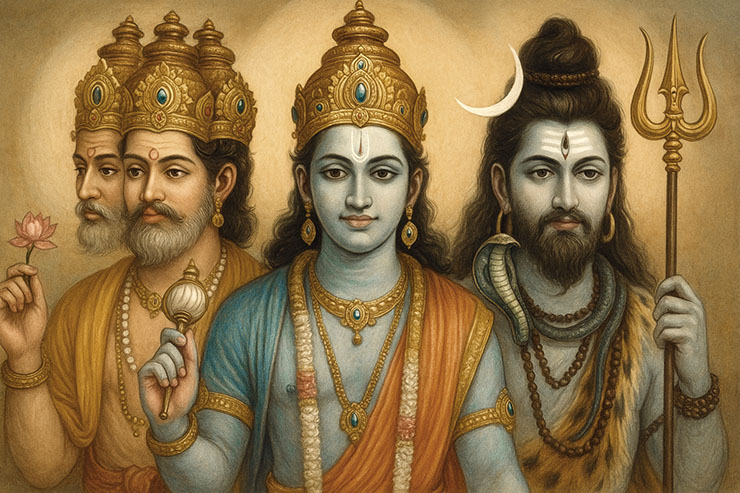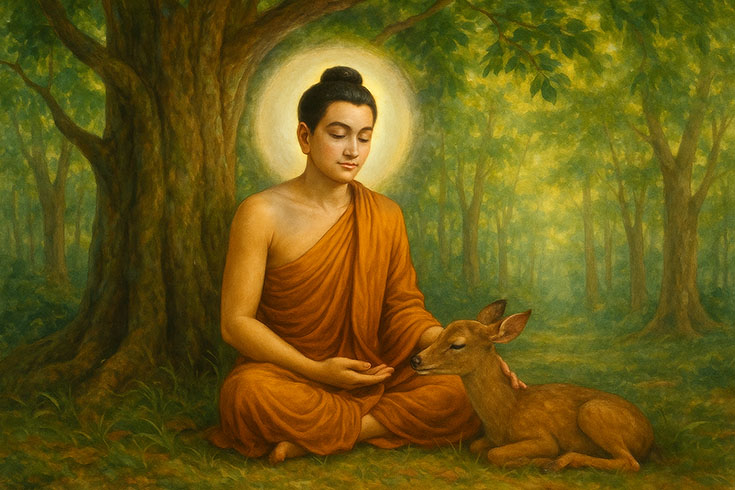VARANASI AND THE SACRED RIVER GANGES EARLY MORNING ------------------ The stories of the 5 Avatar Advents in India -- Throughout history, every Avatar in India has visited Varanasi, an ancient city, that is a sacred pilgrimage destination for Hindus, Buddhists, Sikhs, and seekers alike. Within its boundaries, one can find the revered Kashi Vishwanath Temple of Shiva, as well as ruins of Buddha's ashram in Sarnath, surrounded by Buddhist temples representing various nations. Varanasi embraces diversity with the presence of the many Hindu temples, Alamgir Mosque and Christian churches, while being blessed by the holy waters of the river Ganges that flow through the city. ------------------------------------------------ A thriving spiritual and cultural center on the banks of the Ganga. Kashi has long been renowned as a city of light, a beacon of sacred knowledge and ritual. The Atharva Veda, composed centuries earlier, praises Kashi as a place of deep spiritual potency. Pilgrims, sages, and seekers had been arriving for generations, drawn by the sacred river and the city's long associathion with Shiva, centuries, before the rise of monumental stone temples.
BRAHMA creator, VISHNU preserver and SHIVA destroyer. Manifests through various Avataric incarnations —a Sanskrit word meaning "descent." Each avataric advent represents a distinct form of divine intervention, tailored to the needs of the time. In this 7,000 year cycle of incarnations are Zoroaster, Rama, Krishna, Buddha, Jesus, Muhammad, and Meher Baba. This website is dedicated to the 5 Avataric advents that have occurred in India. Jesus was an avataric descent who, after his crucifixion, journeyed eastward and spent his final days in Kashmir. Meher Baba began as the Avatar January 1922, when the perfect master, Shri Upasni Maharaj folded his hands before him, saying, “Merwan (Meher Baba), You are Adi Shakti. You are the Avatar!” God in Human Form incarnates on Earth, time after time. When He takes a birth, in human form, He is called the Avatar. He visited Varanasi when He came as Ram, Krishna, Buddha, Jesus and when Meher Baba. In the beginning there was... and creation became. In a wave in the ocean of God a million million drops were ejected and they became separated from God, or so they thought. Illusion was created for the millions of souls to journey through, until they can find themselves as being part of the ocean. One by one, over eons, each drop is ready to shed illusion and see itself as God. It does require a push from a soul who has already seen itself. One drop, that first drop to discover itself, returns into illusion, time and time again to give a push to all humanity and a push to many who are closer to the end of their journey. and that final step of spiritual progress is through the doorway of love. ---------------------------------------
Rama and Krishna were not originally part of early Vedic religion. Hinduism is not a creation of the Aryans, but a fusion: Aryan Vedic religion + indigenous Dravidian and tribal beliefs. Resulting in the diverse, layered religion we now call Hinduism, While Rama and Krishna are not mentioned in the early Rigveda, stories about them began to emerge between 500 and 200 BCE.. The first Aryan migration into India was 3,500 years ago. The Aryans came from the North, first through Kashmir. Until then, the Indian population was very dark skinned. Rama and Krishna were very dark skinned. The Aryans were lighter skinned. Hindu nationalists are reluctant to admit that the Aryans were not the first inhabitants of India and that the Harappan civilisation existed long before their arrival. Aryans and their Vedic culture were not the earliest sources. Ram and Krishna were before the Aryans arrived in India. Rama appears in the Ramayana, traditionally attributed to Valmiki. The Ramayana was composed between 500 BCE and 100 BCE, likely building on oral legends. Rama is depicted as a noble prince, a perfect dharmic king, and an incarnation (avatar) of Vishnu. His life illustrates dharma, or righteousness, in action. His story spread widely across India and Southeast Asia through oral retellings and local adaptations. Krishna appears in the Mahabharata, including the Bhagavad Gita. He is portrayed as a prince, friend, and divine guide in the Mahabharata, composed between 400 BCE and 400 CE. In the Bhagavad Gita, dated around 200 BCE to 100 CE, Krishna is a fully divine being—an avatar of Vishnu, the supreme God—who teaches Arjuna about karma, bhakti, and jnana. His childhood tales and romantic leelas, or divine plays, developed separately in folk traditions and were later compiled in texts such as the Harivamsa and the Bhagavata Purana. Rama is upheld as the ideal man (Maryada Purushottama). Krishna is adored not only as a hero but also as a cosmic God, a playful child, a divine lover, and a supreme being. https://www.youtube.com/watch?v=VNsmzZFmNQY Seven names of God. ____________________________ INDIA, TABLE OF CONTENTS : JOURNEYS, FABRICS: SUPERSTRUCTURE _____________________________ This present Avataric cycle started with Avatar Zoroaster 5,000 BCE. There are 24 advents in this 7,000 year cycle of which 7 are major advents and 17 are minor advents. 5 of these Major Avataric Advents occurred, or partially occurred in India. RAMA KRISHNA BUDDHA JESUS MEHER BABA ------------------ The stories of the 5 Avatar Advents in India Throughout history, every Avatar in India has visited Varanasi, an ancient city, that is a sacred pilgrimage destination for Hindus, Buddhists, Sikhs, and seekers alike. Within its boundaries, one can find the revered Kashi Vishwanath Temple of Shiva, as well as ruins of Buddha's ashram in Sarnath, surrounded by Buddhist temples representing various nations. Varanasi embraces diversity with the presence of the many Hindu temples, Alamgir Mosque and Christian churches, while being blessed by the holy waters of the river Ganges that flow through the city. Kashi in the Time of the Buddha (c. 650 BCE)When the Buddha delivered his first sermon at Sarnath, just outside modern-day Varanasi, around 650 BCE, the city of Kashi was already ancient.
Kashi in the Time of the Buddha (c. 650 BCE)Buddha created his ashram in Sarnath, called the deer park, some kilometers from Kashi, a thriving spiritual and cultural center on the banks of the Ganga. By then, Kashi had long been renowned as a beacon of sacred knowledge and ritual. Pilgrims, sages, and seekers had been arriving for generations, drawn by the sacred river and the city's long association the early Vedic form of Shiva. In those early centuries, before the rise of monumental stone temples, the worship of Shiva likely took place at open-air shrines, wooden alters and sacred groves. A simple lingam, placed under a tree or beside the river, could have drawn daily offerings. Kashi Vishwanath Temple: A Sacred LegacyThe Kashi Vishwanath Temple, located in Varanasi (also known as Kashi or Benares, now Varanasi), is one of the most revered Hindu temples dedicated to Lord Shiva. It is among the twelve Jyortirlingas, which are considered the holiest Shiva temples. The temple has a tumultuous history, having been destroyed and rebuilt multiple times. Notably, it was demolished by Mughal Emperor Aurangzeb in 1669, who constructed the Gyanvapi Mosques on its site. Despite these challenges, the temple remained a vital center of worship for Hindus. Restoration by Ahilyabai HolkarIn 1780, Ahilyabai Holkar, the queen of the Maratha Malwa kingdom, undertook the significant task of rebuilding the Kashi Vishwanath Temple adjacent to the original site. Her devotion and efforts restored the temple's sanctity, allowing it to continue as a major pilgrimage site. Ahilyabai's contributions to temple restoration across India have cemented her legacy as a patron of Hindu architecture and spirituality. Kashi Vishwanath CorridorUnder the leadership of Prime Minister Narendra Modi, the temple complex has undergone a transformative redevelopment through the Kashi Vishwanath Corridor Project. Launched in 2019 and inaugurated in December 2021, the project aimed to enhance the temple's accessibility and infrastructure. Key features include:
The River Ganges springs forth from snow melt in the Himalayas and runs across northern India until it exits into the sea in Calcutta. Varanasi (formerly Benares or Kashi) is the spiritual center of pilgrimage for Buddhists. Buddha began his Avatarship in Sarnath ( near to Varanasi). Hindus alike believe that to bathe in the River Ganges is to cleanse ones soul and all try to make the pilgrimage during their lives. Elderly people come to Varanasi to die and have their bodies cremated and floated away down the River. Varnasi is not a tourist place, but many tourists come to see it. There is a feeling of spirituality that envelopes Varanasi, especially boating on the Ganges at dawn. It is an old city with twisted roads and traffic. Cows wander in the streets and alley ways. Varanasi is not the new and modern India.
Each time the Avatar has come to Varanasi, He has touched his feet in the river's waters. There are more than 1,500 temples. "Since ancient times, the holy city of Benares has been the abode of saints, rishis and highly advanced souls. As such, it is imbued with a spiritual atmosphere, congenial, and helpful to any spiritual aspirant or seeker. As to the shrines and temples that abound here, it is not the walls of bricks and stones, but the atmosphere and environment here that breathe spirituality because of the presence of advanced souls.
A little scary, the overcrowding on these boats on the Ganges River, early morning. Lord Rama, Lord Krishna, Lord Buddha and Lord Jesus visited Varanasi/Kashi. Avatar Meher Baba visited. Kabir was a weaver in Kashi. Guru Nanak visited Kashi in 1507, a trip that played a large role in the founding of Sikhism Poets, writers, and musicians live or have lived in the city. 'Benares gharana' form of Hindustani classical music was developed. Varanasi is Famous for its silk weavers, perfumes and crafts. In addition to its 3,300 Hindu religious places, Varanasi has 12 churches,three Jain mandirs, nine Buddhist shrines, three Sikh shrines, and 1,388 Muslim holy places. One of Asia's largest residential universities is 'Banaras Hindu University', created in 1916. Ann Besant founded the college because she wanted "to bring men of all religions together under the ideal of brotherhood in order to promote Indian cultural values and to remove ill-will among different sections of the Indian population." RAMA KIRSHNA BUDDHA JESUS and MEHER BABA Have all spent time in Kashi. __________________________________________ INDIA, TABLE OF CONTENTS : JOURNEYS, FABRICS: SUPERSTRUCTURE __________________________________________________ Advents in India ------------------------------------------------------------- The stories of the 5 Avatar Advents in India --------------------------------------- SARNATH: LORD BUDDHA SEAT
The story of Buddha. 700 BC Sarnath remained abandoned until 1834 when Alexader Cunningham excavated the site. Sarnath attractions to visit https://timesofindia.indiatimes.com/travel/destinations/sarnath-attractions-that-you-shouldnt-skip/gs56469286.cms HOW TO VISIT: Sarnath is a mere 10 Km from Varanasi through congested traffic. There are flights from Delhi and elsewhere to Varanasi. You can drive from Lucknow, a 4 hour drive, or less. Trains arrive from all over India. There are hotels in Sarnath and many hotels in congested Varanasi and by the ghats overlooking the River Ganges. A good hotel by the railway station with excellent food is: Hotel Four Elements. The stories of the 5 Avatar Advents in India Story of Meher Baba STORY MEHER BABA . SAMADHI VISIT RELEVANT WEBSITES ABOUT MEHER BABA:
| ||||||||||||||||||||||
-----------------------------------------------------
BUDDHIST STUPA JUST NORTH OF VARANASI in SARNATH
Sarnath was the seat of Buddha and Lord Buddha's teachings.------- -------------
-------------
MORE INDIA PHOTOS: VALLEYS OF THE HIMALAYAS
------------------------------------------------------------------------
JAIN TEMPLE COMPLEX IN THE TOWN OF THE KHAJURAJO TEMPLES
 |
 |
Friendly Jain priest invited us to join them for lunch.
The Jain temple complex was in the same town as Khajurajo Temple .
 |
Water vessels at the Bharatpur market place.
MORE INDIA PHOTOS KINNAUR AND SPITI VALLEYS OF THE HIMALAYAS
CONTD. . . INDIA PHOTOS KINNAUR AND SPITI VALLEYS OF THE HIMALAYAS






